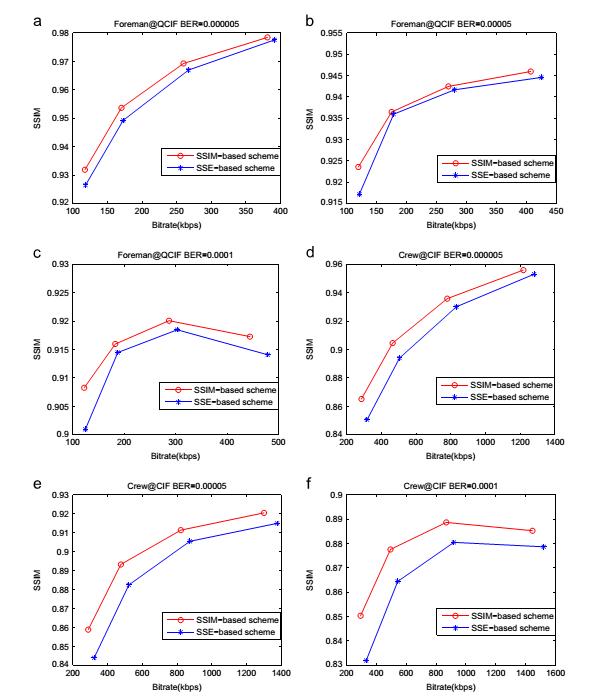With the increasing data transmission capabilities of wireless network and the advancements in the video coding technologies, wireless video applications become more and more popular, such as the video conferencing, video surveillance and video sharing system. However, it is still very challengeable to maintain good video quality for the end users, since it may suffer a lot from the packet loss and the propagated errors caused by the referenced video packets which are incorrectly decoded during transmission.
Recently, a lot of new objective metrics are proposed to measure the video quality. Among them, the Structural Similarity (SSIM) index has been shown to be more accurate and simpler to be calculated. To promote the perceptual video coding performance, researchers have introduced the SSIM metric into the video encoder to measure the encoding distortion. The above works can achieve the SSIM-based rate-distortion performance improvement for the video streaming in the error-free environment, but they do not work efficiently in the error-prone environment because they do not consider the effects of the transmission condition and the error concealment on the perceived video quality.
Researchers from the Institute of Acoustics, Chinese Academy of Sciences, University of Chinese Academy of Sciences and Zhejiang Wanli University (Ningbo) cooperate to have proposed a SSIM-based error-resilient rate-distortion optimization (RDO) of H.264/AVC coding scheme to improve the perceptual video quality for wireless video streaming.
With the help of the sum of squared error (SSE)-based RDO, a low-complexity Lagrange multiplier decision method is presented for the SSIM-based RDO video coding in the error-free environment. And then, the SSIM-based decoding distortion of the user end is estimated at the encoder and is correspondingly introduced into the RDO to involve the transmission induced distortion into the encoding process. Further, the Lagrange multiplier is theoretically derived to optimize the encoding mode selection in the error-resilient RDO process. Compared to the SSE-based error-resilient RDO scheme, the proposed SSIM-based error-resilient RDO scheme can better consider the structural information maintenance for the received videos by the end users during the encoding mode selection process. Objective and subjective evaluation results indicate that the proposed SSIM-based error-resilient RDO can obtain superior perceptual video quality (more structural information) to the traditional SSE-based error-resilient RDO for wireless video streaming at the same bit rate condition (Fig. 1).

Fig. 1 The performance comparisons of the proposed scheme to the SSE-based scheme at the conditions of BER=5×10−6((a) and (d)), BER=5×10−5 ((b) and (e)), and BER=1×10−4 ((c) and (f)) (Image by ZHAO).
This research was supported in part by Important National Science and Technology Specific Project under Contracts 2012ZX03003006-004, NSFC under Grant nos. 11161140319 and 61102077, Ningbo Natural Science Foundation under Contract 2012A610044, Zhejiang Provincial Natural Science Foundation of China under Contract LY13F010012 and NSF under Grant nos. 1145596 and 0830493.
Journal References:
ZHAO Pinghua, LIU Yanwei, LIU Jinxia, CI Song and YAO Ruixiao. SSIM-based Error-resilient Rate-distortion Optimization of H.264/AVC Video Coding for Wireless Streaming. Signal Processing: Image Communication (vol. 29, no. 3, pp. 303–315, MAR 2014). DOI: 10.1016/j.image.2013.12.004
Corresponding Author:
LIU Yanwei
High Performance Network Laboratory, Institute of Acoustics, Chinese Academy of Sciences, Beijing 100190, China
Email: liuyw@hpnl.ac.cn


